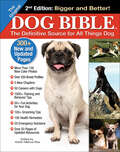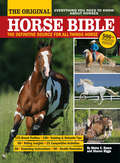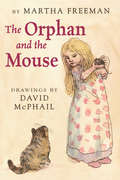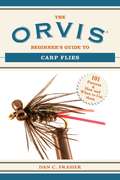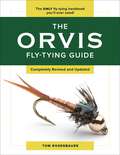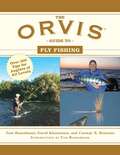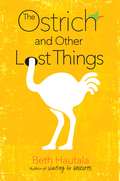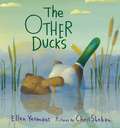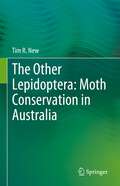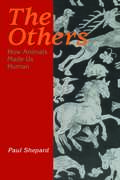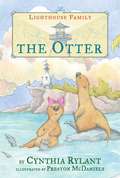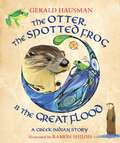- Table View
- List View
The Original Dog Bible: The Definitive Source for All Things Dog
by Kristin Mehus-RoeThe wooftasticsecond edition. &“This attractive, copiously illustrated easy-to-understand volume covers every aspect of responsible dog ownership.&” —Library Journal The revised and expanded second edition of the bestselling The Original Dog Bible remains the most comprehensive dog lover&’s resource on the market! The book is divided into eight parts—each fully illustrated and designed for easy reference—plus helpful, entertaining sidebars covering hundreds of related topics. With detailed chapters on the requirements of caring for a dog, health, training, and so much more, this book will prepare you for a wonderful life with a dog. Also included is a catalog of over 250 purebred dog breeds with insightful articles for each!&“Being a veteran veterinarian of twenty five years and a lifetime pet lover, I can enthusiastically say &‘this old doc learned new tricks&’ upon reading the consummate book on all things dogs . . . I highly recommend it!&” —Dr. Marty Becker, former resident veterinarian on ABC&’s Good Morning America and coauthor of Chicken Soup for the Dog Lover&’s Soul&“This comprehensive book certainly lives up to its subtitle . . . The best part of the book, however, covers &‘life with a dog,&’ with sections on pet care partners like sitters and walkers, emergencies, lost dogs, biting, traveling with a dog, and a fantastic chapter on activities one can do with one&’s dog.&” —Publishers Weekly
The Original Horse Bible: The Definitive Source for All Things Horse
by Moira C. Reeve Sharon BiggsThe most comprehensive single volume dedicated to horses, The Original Horse Bible is a celebration of the long relationship that humans and horses enjoy, written by two highly regarded horsewomen, the late Moira C. Allen and Sharon Biggs. <P><P>This 480-page volume, elaborately illustrated by world-renowned horse photographer Bob Langrish, is divided into eleven sections, covering topics that span the world of horses, from evolution and domestication to horse riding, training, competitions and more.Section 1: "History, Physiology, and Behavior" discusses the natural history of the horse, including adaption, migration, and domestication, how horses became integral to human kind, the role of horses in society (war horses, law-enforcement horses, race horses), as well as animal welfare and the plight of wild and feral horses. The anatomy and physiology of the horse are detailed in discussions of the horse's bodily systems, structure, senses, gait/movement, and coat and color patterns. In terms of behavior, the authors discuss the life cycle of the horse and reproduction, intelligence and trainability, and horse mentality and natural instincts.In Section 2: "Breeds and Types," the authors trace the evolution of modern horse types from three known ancient ancestors and archaic types and extinct breeds. They describe the modern types of horses based on their particular looks and specific uses (Baroque, Cob, Hack, Hunter, Polo Pony and so forth). A detailed discussion of horse color follows, explaining the differences between each and what specific characteristics define each (buckskin, palomino, and pinto).The extensive breed chapter offers portraits of approximately 175 breeds, alphabetically arranged, from the Abaco Barb to the Welsh Pony, including many rare and handsome breeds from around the world as well as favorites like the American Quarter Horse, the Shetland Pony and the Thoroughbred. Main entries provide alternative names, region of origins, brief history, and physical descriptions for each breed. Sidebars called "Breed in Brief" offer concise overviews of the lesser known breeds.The popular hobby of horse riding is the focus of Section 3: "Activities with Horses," which describes English, western, and driving competition as well as rodeo, competitive trail riding, vaulting, polo, and other horse sports. Section 7: "Rider Instruction" continues the discussion on riding with chapters on riding instructions, safety and fitness as well as English and western riding skills.In Section 4: "A New Horse" and Section 5 "Horsekeeping," the Bible becomes a primer for all horse owners offering detailed information about choosing the right horse for novice riders, families, and experienced riders and purchasing the horse and the proper equipment (saddles and bridles, boots, gear, and gadgets). The section concludes with chapters on transporting horses, stabling and boarding, and feeding and grooming. Section 6: "Health" discusses veterinary care and vaccines, recognizing the signs of a healthy animal, first aid for each area of the horse's anatomy, hoof care, and winter wear. A complete chapter is dedicated to battling parasites and pests and avoiding poisonous plants in the horse's environment. A chapter on alternative care completes the section.Section 8:"Horse Training" focuses on various training philosophies and early handling, training lessons, solving training problems (leading, bolting, biting/nipping, rearing/buckling and shying)
The Origins and Nature of Sociality
by Robert W. SussmanScientific developments have increasingly been transforming our understanding of the place of human beings in nature. The contributors to this book focus on the current status of research on sociality and the evolution of cooperative and altruistic behaviour in non-human and human primates. They examine questions related to the evolution, cultural viability, and hormonal underpinnings of human sociality in specific detail, and describe patterns of sociality that shed light on human social behaviour.
The Origins of Language Revisited: Differentiation from Music and the Emergence of Neurodiversity and Autism
by Nobuo MasatakaThis book summarizes the latest research on the origins of language, with a focus on the process of evolution and differentiation of language. It provides an update on the earlier successful book, “The Origins of Language” edited by Nobuo Masataka and published in 2008, with new content on emerging topics.Drawing on the empirical evidence in each respective chapter, the editor presents a coherent account of how language evolved, how music differentiated from language, and how humans finally became neurodivergent as a species. Chapters on nonhuman primate communication reveal that the evolution of language required the neural rewiring of circuits that controlled vocalization. Language contributed not only to the differentiation of our conceptual ability but also to the differentiation of psychic functions of concepts, emotion, and behavior. It is noteworthy that a rudimentary form of syntax (regularity of call sequences) has emerged in nonhuman primates. The following chapters explain how music differentiated from language, whereas the pre-linguistic system, or the “prosodic protolanguage,” in nonhuman primates provided a precursor for both language and music. Readers will gain a new understanding of music as a rudimentary form of language that has been discarded in the course of evolution and its role in restoring the primordial synthesis in the human psyche. The discussion leads to an inspiring insight into autism and neurodiversity in humans. This thought-provoking and carefully presented book will appeal to a wide range of readers in linguistics, psychology, phonology, biology, anthropology and music.
The Orphan Orangutan: Book 4 (The Adventure Club #4)
by Jess ButterworthDo you like exploring, animals and adventure? Then join The Adventure Club! A new illustrated series for younger readers about animals and adventure from much-loved author Jess Butterworth - writer of classic adventure stories in vibrantly described settings.It's time for the fourth Adventure Club trip, and this time Tilly and the Adventure Club are off to Borneo. When the team find an orphan orangutan alone in the wild after a fire, they rescue it and the baby orangutan takes a special liking to Tilly. But can the Adventure Club train to the baby to live in the wild without her mum? And if they do, how will Tilly ever be able to leave her behind? Join the Adventure Club to find out!Packed full of illustrations and set as Tilly's own diary, this new series is perfect for young readers who are beginning to read on their own.
The Orphan Seal
by Fran HodgkinsBased on the actual rescue and rehabilitation of a seal named Howler and accompanied with vivid illustrations, the story of this endearing young seal will find a place in every reader's heart.
The Orphan and the Mouse
by Martha Freeman David McPhailMary mouse is a skilled thief of useful human items. At the Cherry Street Children's Home, the entire mouse community admires her . . .until a mission goes wrong and an exterminator is called. Suddenly Mary is in grave danger of being exiled. Ten-year-old Caro McKay also resides at Cherry Street. Helpful, likable, and smart, she is a model orphan . . .until her curiosity gets her into trouble. When mouse and orphan meet, they cannot fully communicate with each other, yet they feel an understanding. They will each discover that this unusual friendship is absolutely vital as they try to hold on to the lives they know. Set in 1949 and taking inspiration from E. B. White's Stuart Little, this heartwarming and exciting novel reads like a classic.
The Orvis Beginner's Guide to Carp Flies: 101 Patterns & How and When to Use Them (Orvis Guides)
by Dan C. FrasierLearn tips and tricks for all new flies sure to catch carp!Carp are one of the most widely distributed and abundant fish in North America. Their prodigious size and habit of finning in shallow water make them appear to be easy fly-fishing targets. In reality, most anglers quickly discover that they are extremely difficult to hook on a fly. It takes years to discover how to catch them consistently. The reason? Carp can be very selective about what flies they will take.This book will help to short-circuit that learning curve. Carp's selectivity can be boiled down to diet. Understanding what they are eating allows the angler to choose and tie a fly that will produce. The Orvis Beginner's Guide to Carp Flies walks the flyfisherman through the steps of identifying the most likely food source, illustrating the best patterns that imitate that food, and discussing how to effectively present those flies. With detailed information on tying all of the important carp flies, this book eliminates months of trial and error in your fly selection.
The Orvis Fly-Tying Guide
by Tom RosenbauerThis essential book on fly tying will teach anyone how to tie flies. All the important techniques are illustrated with color photographs, from starting the thread on the hook to whip finishing. The book lays the basic ground work by fully explaining simple tying techniques, and then progresses to detailed tying instructions for some of the most popular, modern patterns. How to choose and prepare the correct material, and all the necessary tying steps for each fly, are detailed in superb, large, color photographs.Even if you have no previous tying experience, you'll be able to tie dries, nymphs, streamers, saltwater offerings, and bass bugs after just a few sessions with this book. The tyer is then advised how to progress to similar patterns using the same basic techniques. Also included is a huge reference of fly patterns - more than four hundred flies from the Orvis catalog are shown in full color, along with the tying recipes and proportions for each one. This book, drawing from the Orvis Company's vast resources and teaching experience and written by an author whose name is synonymous with Orvis, has become the bible for fly-tyers of all skill levels.
The Orvis Guide to Fly Fishing: More Than 300 Tips for Anglers of All Levels (Orvis Guides)
by David Klausmeyer Conway X. Bowman Tom RosenbauerIn this compendium of fly fishing from three of the most respected names in the sport, Tom Rosenbauer, David Klausmeyer, and Conway X. Bowman share all of their most successful fly-fishing secrets. With tips on fresh- and saltwater fly fishing and tying flies, this book will help readers become the best flyfishermen they can be. The chapters discuss a wide range of fly-fishing topics, including:Choosing the right equipment, such as rods, reels, fly lines, and wadersCasting under different conditionsHow to find and catch troutWhich tides are best for saltwater fly fishingEssential items to pack for a saltwater fly-fishing tripHow to prepare for emergency situationsTaking care of your tackleSelecting the right materials for tying fliesTying dry flies that ride higher and float longerAnd much moreNever has there been a more comprehensive guide to the fulfilling sport of fly fishing. To catch that trophy you've been waiting for, The Orvis Guide to Fly Fishing is the perfect companion on your next fly-fishing adventure.
The Orvis Quick-Start Guide to Fly-Fishing: Everything You Need to Know to Catch Fish Your First Time Out
by Philip MonahanBuy this book on a Wednesday, and you could be out catching fish on Saturday morning!The Orvis Quick-Start Guide to Fly Fishing is the only book a first-time angler needs to go from zero to catching fish in no time at all. Many people believe that learning to fly-fish is very difficult, but the truth is that, with a little expert instruction, anyone can become a successful fly fisher in a matter of days. Phil Monahan&’s just-the-basics approach will teach you what makes fly-fishing so special, exactly what tackle and gear you need for any given fishing situation, how to cast a fly rod, and fundamental fly-fishing techniques that catch fish. Everything is explained simply, clearly, and concisely without a lot of extraneous information, so you&’ll have the knowledge and skills to go out on the water with confidence. Important topics include: Tackle Selection—Making sure you have the right tools Casting—Including step-by-step photos featuring Orvis instructor Pete Kutzer Fish Biology and Behavior—Understand the species you're targeting Basic Entomology and Fly Selection—How to identify and imitate the bugs trout eat How to Read Water—Learn where fish live in rivers and lakes Fly Presentation—How to put all this knowledge together to catch fish Warmwater Fly Fishing—A whole chapter on how to catch bass and panfish
The Orvis Streamside Guide to Approach and Presentation: Riffles, Runs, Pocket Water, and Much More (Orvis Guides)
by Tom RosenbauerI know how to cast, I know my knots, and I can tell a dry from a wet fly. What next? This pocket guide shows the fly fisher where to cast, why, and what kind of fly to use. It can be studied prior to a fishing trip or used in the water.Streamers, nymphs, wets, and dry flies are detailed with diagrams and color photographs. The book is organized by water types, and once you identify what kind of water you are facing—riffles, runs, pocket water, or deep slow water—you can then decide what kind of fly to use, what leader is appropriate, and how to present the fly. Chapters cover topics such as:How to enter a poolAngle and attitude of approachMidstream rocksHead, middle, and tail of a poolRiffles and runsEtiquetteAnd much more!No more days of returning without a catch. With the extensive experience and knowledge of author Tom Rosenbauer, you can use his no-nonsense tips to identify appropriate fly-fishing wet and dry flies, adapt to current water conditions, and cast with confidence.
The Orvis Streamside Guide to Trout Foods and Their Imitations (Orvis Guides)
by Tom RosenbauerEvery fly fisher would agree that knowing your mayflies from your stoneflies is strongly correlated with a successful day on the water. This knowledge is vital because, as author Tom Rosenbauer notes, trout are shy and careful and can be fussy about what they eat. In addition, they won't hesitate to swim away and leave a meal if they feel threatened.In The Orvis Streamside Guide to Trout Foods and Their Imitations, Rosenbauer explains how and when to use many types of trout foods, including aquatic insects, terrestrial insects, crustaceans, and more. Designed with both the novice and intermediate fly fisher in mind, Rosenbauer teaches readers how to:Ambush troutIdentify types of insectsPresent trout food properlyObserve what trout are eatingUse imitation trout foodsAnd moreWith The Orvis Streamside Guide to Trout Foods and Their Imitations at their sides, fly fishermen will be able to tell the difference between mayflies, stoneflies, caddisflies, midges, and a variety of other insects. In addition, they will also know when to use real foods and when to rely on the imitations in their tackle boxes.
The Ostrich and Other Lost Things
by Beth Hautala<P>In this beautifully written novel, the bonds and challenges of caring for a sibling with autism are bravely explored, along with the pain and power that comes from self-discovery. <P>Eleven-year-old Olivia Grant has a knack for finding lost things. She can find lost rings, pets, and even her elderly neighbor's misplaced glasses. There's only one thing Olivia has never been able to find--her brother Jacob's toy ostrich. It wasn't until the day Jacob lost his ostrich that Olivia noticed how different he was: Jacob is autistic, and though she's his little sister, Olivia often feels like the older of the pair, his caretaker. And with her parents so heavily focused on maintaining status quo for Jacob, it's Olivia who has stagnated in his shadow--unable to explore new opportunities, or to be her own person. In fact, apart from being Jacob's sister, Olivia's not really sure who she is. <P>So when summer break begins, and the local community theater announces auditions for an all children's production of her favorite show, Peter Pan, Olivia jumps at the chance to claim something for herself. But what begins as a promising opportunity and a wonderful escape quickly becomes pure chaos. The visiting zoo with an odd assortment of animals--including an ostrich that causes even more trouble than Jacob's missing toy--only make matters worse, as Olivia's summer is shaping up to be just as consumed by Jacob's needs as the rest of her life has been. In time, and with the help of some unlikely alliances, Olivia must learn what it means to be separate from her brother and still love him, how to love herself in spite of her own flaws, and that not all lost things are meant to be found.
The Other Dog
by Madeleine L'Engle Christine DavenierTouche L'Engle-Franklin is confused: Her mistress goes away for several days and then returns with another dog. But this dog doesn't have a tail. She doesn't have much hair. And she never has to go outside when it's raining. What on earth could the family want with that inferior breed known as Baby? Based on the true tale of her own poodle's experience coping with a new baby in the house, Newbery-winning author Madeleine L'Engle gives this familiar domestic drama an utterly charming new twist. Tongue-in-cheek wit, endearing illustrations, and a revealing author's note make this a publishing event to celebrate.
The Other Ducks
by Ellen YeomansThis Duck and That Duck were the best of friends. They did everything together but sometimes two ducks just isn’t enough.When This Duck declares that he wishes there were Other Ducks around so they could waddle in a line (a very ducky thing to do), That Duck is quite confused.That is until This Duck and That Duck go swimming, look down, and finally meet The Other Ducks.Unfortunately, The Other Ducks never seem to come out of the water! Oh how This Duck and That Duck wish The Other Ducks would waddle outside the big puddle with them. But it’s getting colder and their feathers are starting to itch for warmer weather.Will these best friends ever find their companions? Join This Duck and That Duck in this witty and heartfelt tale as they discover the world around them.
The Other End of the Leash: Why We Do What We Do Around Dogs
by Patricia B. McconnellThe Other End of the Leash shares a revolutionary, new perspective on our relationship with dogs, focusing on our behavior in comparison with that of dogs. An applied animal behaviorist and dog trainer with more than twenty years experience, Dr. Patricia McConnell looks at humans as just another interesting species, and muses about why we behave the way we do around our dogs, how dogs might interpret our behavior, and how to interact with our dogs in ways that bring out the best in our four-legged friends. <P><P> After all, although humans and dogs share a remarkable relationship that is unique in the animal world, we are still two entirely different species, each shaped by our individual evolutionary heritage. Quite simply, humans are primates and dogs are canids (like wolves, coyotes, and foxes). Since we each speak a different native tongue, a lot gets lost in the translation.<P> The Other End of the Leash demonstrates how even the slightest changes in your voice and the way you stand can help your dog understand what you want. Once you start to think about your own behavior from the perspective of your dog, you’ll understand why much of what appears to be doggy-disobedience is simply a case of miscommunication. Inside you will learn<P> • How to use your voice so that your dog is more likely to do what you ask.<P> • Why “getting dominance” over your dog is a bad idea.<P> • Why “rough and tumble primate play” can lead to trouble–and how to play with your dog in ways that are fun and keep him out of trouble.<P> • How dogs and humans share personality types–and why most dogs want to live with benevolent leaders rather than “alphawannabees!”<P> In her own insightful, compelling style, Patricia McConnell combines wonderful true stories about people and dogs with a new, accessible scientific perspective on how they should behave around each other. This is a book that strives to help you make the most of life with your dog, and to prevent problems that might arise in that most rewarding of relationships.
The Other Family Doctor: A Veterinarian Explores What Animals Can Teach Us About Love, Life, and Mortality
by Karen FineNEW YORK TIMES BESTSELLER • Calling all animal lovers! A heartwarming memoir about one woman's career as a vet and the unique role pets play in our lives • &“Filled with compassion and wisdom, Karen Fine is a healer whose own wounds have deepened her gifts for bringing animals and their people comfort and peace.&” —Sy Montgomery, bestselling author of The Soul of an Octopus A tribute to our furry, feathery, scaley, and wet family members, All Creatures Great and Small meets Being Mortal in this compelling memoir of one woman's dream to become a veterinarian.Karen Fine always knew that she wanted to be a vet and wasn't going to let anything stop her: not her allergy to cats, and not the fact that in the '80s veterinary medicine was still a mostly male profession. Inspired by her grandfather, a compassionate doctor who paid house calls to all his (human) patients, Dr. Fine persevered, and brought her Oupa's principles into her own practice, which emphasizes the need to understand her patients&’ stories to provide the best possible care. And in The Other Family Doctor, Dr. Fine shares all these touching, joyful, heartbreaking, and life-affirming tales that make up her career as a vet. There's:• The feral cat who becomes a creature out of a fable when he puts his trust in a young vet to heal his injured paw• The pot-bellied pig who grows too big to fit in the car but remains a cherished part of her family • The surprising colony of perfectly behaved ferrets• The beloved aging pet who gives her people the gift of accompanying them on one final family vacation• The dog who saves his owner's life in a most unexpected way Woven into Dr. Fine's story are, of course, also the stories of her own pets: the birds, cats, and dogs who have taught her the most valuable lessons—how caring for the animals in our lives can teach us to better care for ourselves, especially when life seems precarious.
The Other Lepidoptera: Moth Conservation in Australia
by Tim R. NewConservation interest in moths, by far the predominant components of Lepidoptera, lags far behind that for butterflies, for which conservation practice provides many well-established lessons for extension to their near relatives. The needs of moths are at least as great, but their greater richness and variety, and far poorer documentation of diversity and biology over much of the world contribute to this lack of attention. Australia’s rich moth fauna, largely endemic and of global interest, illustrates many of the problems of developing wider interest and support for moth conservation. Numerous species (perhaps half the total fauna) are undescribed, and many are ecological specialists in restricted and vulnerable environments over small parts of the continent. Establishing their conservation status and needs whilst accepting that foundation knowledge is highly incomplete and much species-focused conservation is impracticable provides complex problems in setting priorities, based largely on wider diversity and effective advocacy. Most Australian vegetation systems, from grassland to forest and from sea-level to alpine zones, have been eroded in extent and quality since European settlement, resulting in massive habitat changes for native insects and to leave fragmented (and commonly degraded) remnants in which moths and others may persist. Recent surveys continue to increase recorded moth richness, reveal local faunal peculiarities, and indicate how assemblage changes may mirror wider environmental changes. This book is an overview of advances in documenting and interpreting moth diversity and ecology, to show how information from better-studied moth faunas can help in planning conservation of Australia’s moths through measures such as understanding the moths themselves by increased surveys and study, the factors influencing their diversity and wellbeing, and how such threats may be countered through increased coordinated conservation interest, commitment and management.
The Other: The Weakness; The Arrival; The Hidden; The Other (Animorphs #40)
by K. A. ApplegateAx and the Animorphs have always believed Ax was the only non-infested Andalite on Earth. That he alone survived the terrible battle between his people and the Yeerks.Until now.There were other survivors. Other Andalites. And they're here on Earth. Trying to keep a low profile. Trying to find a way to defeat Visser Three. Trying -- like Ax and the Animorphs -- to stay alive until help finally comes.If help finally comes...
The Others: How Animals Made Us Human
by Paul ShepardPaul Shepard has been one of the most brilliant and original thinkers in the field of human evolution and ecology for more than forty years. His thought-provoking ideas on the role of animals in human thought, dreams, personal identity, and other psychological and religious contexts have been presented in a series of seminal writings, including Thinking Animals, The Tender Carnivore and the Sacred Game, and now The Others, his most eloquent book to date.The Others is a fascinating and wide-ranging examination of how diverse cultures have thought about, reacted to, and interacted with animals. Shepard argues that humans evolved watching other animal species, participating in their world, suffering them as parasites, wearing their feathers and skins, and making tools of their bones and antlers. For millennia, we have communicated their significance by dancing, sculpting, performing, imaging, narrating, and thinking them. The human species cannot be fully itself without these others.Shepard considers animals as others in a world where otherness of all kinds is in danger, and in which otherness is essential to the discovery of the true self. We must understand what to make of our encounters with animals, because as we prosper they vanish, and ultimately our prosperity may amount to nothing without them.
The Otter
by Cynthia Rylant Preston McdanielsNewbery Medalist Cynthia Rylant brings the peaceful sounds, sights, and characters of the coast vividly to life in the sixth book of the Lighthouse Family series, in which the family assists an otter in need. On a lovely summer day, the lighthouse family hears the bell on the fog buoy ringing. It is an otter, whose sister is trapped in an old fishing net! With the help of some friendly dolphins and sawfish, the lighthouse family devises a plan to free the trapped otter—and makes two new friends along the way.
The Otter and the Fairy Shrimp
by James H. ThorpThis book presents information on common-to-rare organisms from around the world that inhabit freshwater habitats. The first six chapters focus on organisms from the very small (e.g., protozoa, zooplankton, and fairy shrimp) to the huge (e.g., hippos, freshwater sharks, and giant turtles), while the last four chapters provide information on aquatic ecosystems (lakes, streams, caves, and wetlands). Included in this last section are the physical nature of the system and how that influences the kinds of animals living there. This unique “nature” book, incorporating information from around the world on both aquatic systems and organisms, is written to attract the interest of a wide group of non-academic readers.
The Otter, the Spotted Frog & the Great Flood: A Creek Indian Story
by Gerald HausmanWhen Spotted Frog tells of a great flood that is about to destroy their homes, all of the animals ignore his warnings, except Listener the Otter. Ridiculed by the other animals, Listener heeds Spotted Frog&’s predictions and begins to build a raft to try and survive the impending disaster. But will his efforts be enough?This charming children&’s book warns us to listen to the wisdom of nature and the environment. Based on a traditional story from the Creek Indians of northern Florida and Georgia, this book is retold by award-winning author and storyteller Gerald Hausman, and is brought to life by the powerful images of Ramon Shiloh. This universal tale is imbued with Native American wisdom that is even more prescient now, with the conditions of global warming that threaten our world.
The Outer Lands: A Natural History Guide To Cape Cod, Martha's Vineyard, Nantucket, Block Island, And Long Island
by Dorothy SterlingExperience the unique ecology of the Outer Lands in this reissued classic “An extraordinary achievement in natural history and science. But it’s so artfully written you forget it’s a scientific treatise and find yourself reading it with sheer pleasure.” — Provincetown Advocate Dorothy Sterling explores the fascinating plants and animals that inhabit the peninsulas and islands of the East Coast known as the Outer Lands. With vibrant original drawings by Winifred Lubell and a new foreword by natural historian Robert Finch, The Outer Lands is a lively, lovingly observed biography of place.
